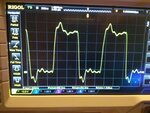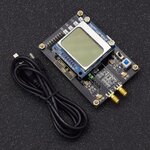Garyl
Full Member level 5
Hey,
I just want to make sure if that's normal..
The AD is driven by Arduino, it's a square/sine signgal generator rated up to 12.5MHz.
It's powered by 5V.
The used Arduino library is here: https://github.com/Billwilliams1952/AD9833-Library-Arduino
The used clock source is 24MHz.
The SQUARE wave is disorted even at 1 MHz:

The sine wave is good at 1MHz, but at 8MHz is "dancing", please watch the video (in zip file):
View attachment dancingsine.zip
The signal generator supply has 100nF SMD capacitor near pins, then a 100nF tantalum THT capacitor, and then 470uF electrolytic capacitor.
I can't think of any reason why the waveforms are not perfect, maybe it's just that they should look like this way?
I just want to make sure if that's normal..
The AD is driven by Arduino, it's a square/sine signgal generator rated up to 12.5MHz.
It's powered by 5V.
The used Arduino library is here: https://github.com/Billwilliams1952/AD9833-Library-Arduino
The used clock source is 24MHz.
The SQUARE wave is disorted even at 1 MHz:

The sine wave is good at 1MHz, but at 8MHz is "dancing", please watch the video (in zip file):
View attachment dancingsine.zip
The signal generator supply has 100nF SMD capacitor near pins, then a 100nF tantalum THT capacitor, and then 470uF electrolytic capacitor.
I can't think of any reason why the waveforms are not perfect, maybe it's just that they should look like this way?



